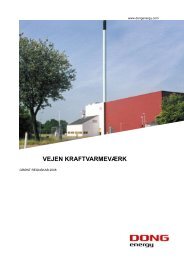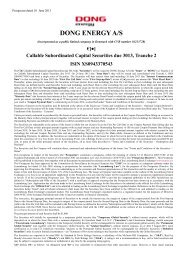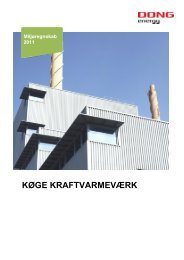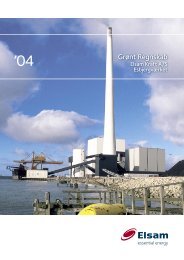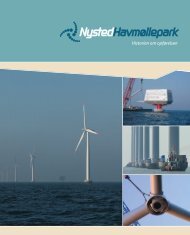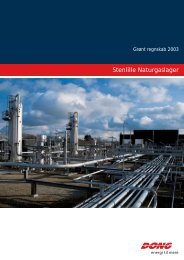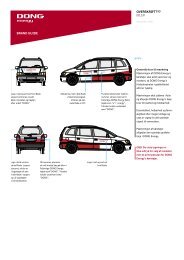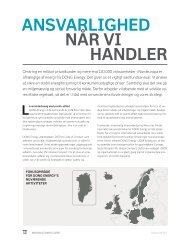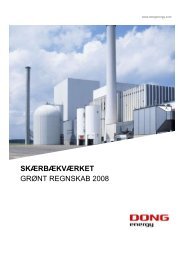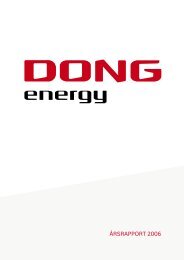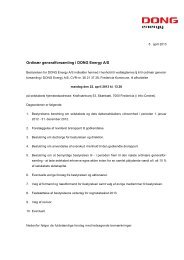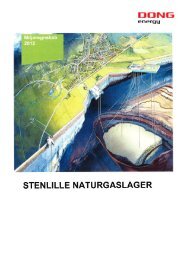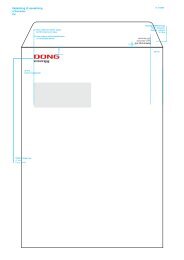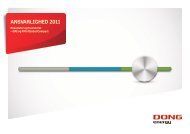ANNUAL REPORT 2011 - DONG Energy
ANNUAL REPORT 2011 - DONG Energy
ANNUAL REPORT 2011 - DONG Energy
Create successful ePaper yourself
Turn your PDF publications into a flip-book with our unique Google optimized e-Paper software.
notes<br />
40 Description of accounting policies<br />
Other bank loans include the capitalised residual lease commitment<br />
under finance leases, measured at amortised cost.<br />
Trade payables, payable income tax and other payables are<br />
measured at net realisable value.<br />
Other payables include negative fair values of derivative financial<br />
instruments.<br />
Financial liabilities the value of which has been effectively<br />
hedged are adjusted to fair value to the extent of the hedged<br />
risk. The value adjustment is recognised in profit for the year as<br />
finance income or costs.<br />
Other accounting policies<br />
Business combinations<br />
Enterprises acquired or formed during the year are recognised<br />
in the consolidated financial statements from the date of acquisition<br />
or formation. The acquisition date is the date on which<br />
<strong>DONG</strong> <strong>Energy</strong> obtains control of the acquiree. On acquisition<br />
of enterprises whereby the parent company obtains control of<br />
the acquiree, the purchase method is applied. The acquiree’s<br />
identifiable assets, liabilities and contingent liabilities are<br />
measured at fair value at the acquisition date. Identifiable<br />
intangible assets are recognised if they are separable or arise<br />
from a contractual right, and the fair value can be measured<br />
reliably. Deferred tax on revaluations is recognised.<br />
The consideration transferred in exchange for an acquiree consists<br />
of the fair value of the agreed consideration in the form of<br />
assets acquired, liabilities assumed and issued equity instruments.<br />
If parts of the consideration are contingent on future<br />
events, these parts of the consideration are recognised in cost<br />
at the acquisition-date fair value. Costs incurred in connection<br />
with a business combination are recognised in profit for the<br />
year as incurred.<br />
The excess of the cost of the consideration transferred in exchange<br />
for the acquiree, the amount of any non-controlling interests<br />
in the acquiree and the fair value of the identifiable assets<br />
acquired and liabilities and contingent liabilities assumed<br />
(goodwill) is recognised as goodwill within intangible assets.<br />
Goodwill is not amortised, but is tested for impairment, at least<br />
annually. The first impairment test is carried out before the end<br />
of the year of acquisition. On acquisition, goodwill is allocated<br />
to the cash-generating units, which subsequently form the basis<br />
for the impairment test.<br />
Goodwill and fair value adjustments in connection with the<br />
acquisition of a foreign entity with a functional currency that is<br />
different from the Group’s presentation currency are accounted<br />
for as assets and liabilities belonging to the foreign entity and<br />
134 COnsOliDatED finanCial statEmEnts – <strong>DONG</strong> ENERGY <strong>ANNUAL</strong> <strong>REPORT</strong> <strong>2011</strong><br />
translated on initial recognition into the foreign entity’s functional<br />
currency at the exchange rate at the transaction date.<br />
Any excess of the fair value over the cost of acquisition (negative<br />
goodwill) is recognised in profit for the year at the date of<br />
acquisition.<br />
If there is any uncertainty, at the acquisition date, concerning<br />
the measurement of identifiable assets acquired and liabilities<br />
and contingent liabilities assumed, initial recognition is based<br />
on provisional fair values. If the fair value of identifiable assets,<br />
liabilities and contingent liabilities subsequently proves to differ<br />
from the fair value assumed at the acquisition date, those<br />
provisional values, including goodwill, are adjusted retrospectively<br />
within 12 months of the acquisition date and comparative<br />
figures are restated. Subsequently, goodwill is not adjusted.<br />
Changes in estimates of contingent consideration are generally<br />
recognised directly in profit for the year.<br />
Non-controlling interests are measured on initial recognition<br />
either at fair value or at their proportionate interest in<br />
the fair value of the acquiree’s identifiable assets, liabilities<br />
and contingent liabilities. In the former case, goodwill relating<br />
to the non-controlling interests’ interest in the acquiree is<br />
recognised, while, in the latter case, no goodwill is recognised<br />
relating to non-controlling interests. The method of measuring<br />
non-controlling interests is determined on an acquisition-byacquisition<br />
basis and disclosed in the notes in connection with<br />
the description of the acquiree.<br />
The effect of acquisitions and disposals of non-controlling interests<br />
after control is obtained is recognised directly in equity.<br />
Net assets acquired are not revalued on acquisition.<br />
Enterprises disposed of during the year are recognised in profit<br />
for the year up to the date of disposal.<br />
Gains or losses on disposal of enterprises and investments in<br />
associates are determined as the difference between the selling<br />
price and the carrying amount of net assets, including goodwill<br />
at the date of disposal and costs necessary to make the sale.<br />
Gains or losses are recognised in profit for the year as gain<br />
(loss) on disposal of enterprises.<br />
Comparative figures are not restated to reflect acquisitions<br />
or disposals; however, discontinued operations are presented<br />
separately.<br />
foreign currency translation<br />
For each of the reporting enterprises in the Group, a functional<br />
currency is determined. The functional currency is the currency<br />
of the primary economic environment in which the individual



